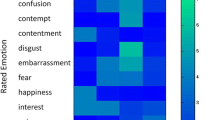Abstract
Micro-expression has gained a lot of attention because of its potential applications (e.g., transportation security) and theoretical implications (e.g., expression of emotions). However, the duration of micro-expression, which is considered as the most important characteristic, has not been firmly established. The present study provides evidence to define the duration of micro-expression by collecting and analyzing the fast facial expressions which are the leakage of genuine emotions. Participants were asked to neutralize their faces while watching emotional video episodes. Among the more than 1,000 elicited facial expressions, 109 leaked fast expressions (less than 500 ms) were selected and analyzed. The distribution curves of total duration and onset duration for the micro-expressions were presented. Based on the distribution and estimation, it seems suitable to define micro-expression by its total duration less than 500 ms or its onset duration less than 260 ms. These findings may facilitate further studies of micro-expressions in the future.


Similar content being viewed by others
Notes
For example, if the coder #1 coded one sample as from 100th to 120th frames and coder #2 as from 105th to 125th frames, then the agreed range is 15 and the total range is 25, the reliability coefficient is 0.6 for this case.
References
Akaike, H. (1974). A new look at the statistical model identification. IEEE Transactions on Automatic Control, 19(6), 716–723.
Ekman, P. (1985/2001). Telling lies: Clues to deceit in the marketplace, marriage, and politics. New York: Norton.
Ekman, P. (2003). Emotions revealed: Recognizing faces and feelings to improve communication and emotional life. New York: Times Books (Henry Holt and Co.).
Ekman, P. (2006). Darwin, deception, and facial expression. Annals of the New York Academy of Sciences, 1000(1), 205–221. doi:10.1196/annals.1280.010.
Ekman, P. (2009). Lie catching and microexpressions. In C. Martin (Ed.), The philosophy of deception (pp. 118–133). Oxford: Oxford University Press.
Ekman, P., & Friesen, W. (1969). Nonverbal leakage and clues to deception. Psychiatry, 32(1), 88–106.
Ekman, P., & Friesen, W. (1974). Detecting deception from the body or face. Journal of Personality and Social Psychology, 29(3), 288–298.
Ekman, P., Friesen, W., & Hager, J. (2002a). Facial Action Coding System (The Manual on CD Rom). Salt Lake City: Network Information Research Corporation.
Ekman, P., Friesen, W., & Hager, J. (2002b). FACS Investigator’s Guide (The Manual on CD Rom). Salt Lake: Network Information Research Corporation.
Ekman, P., & O’Sullivan, M. (2006). From flawed self assessment to blatant whoppers: The utility of voluntary and involuntary behavior in detecting deception. Behavioral Sciences & the Law, 24(5), 673–686.
Ekman, P., & Rosenberg, E. L. (2005). What the face reveals: Basic and applied studies of spontaneous expression using the Facial Action Coding System (FACS) (2 ed.). USA: Oxford University Press.
Frank, M. G., & Ekman, P. (1997). The ability to detect deceit generalizes across different types of high-stake lies. Journal of Personality and Social Psychology, 72(6), 1429.
Frank, M. G., Maccario, C. J., & Govindaraju, V. (2009). Behavior and security. In P. Seidenstat (Ed.), Protecting airline passengers in the age of terrorism (pp. 86–106). Santa Barbara, CA: Greenwood Pub Group.
Gross, J., & Robert, L. (1995). Emotion elicitation using films. Cognition and Emotion, 9(1), 87–108.
Hess, U., & Kleck, R. E. (2006). Differentiating emotion elicited and deliberate emotional facial expressions. European Journal of Social Psychology, 20(5), 369–385.
Hoffmann, H., Traue, H. C., Bachmayr, F., & Kessler, H. (2010). Perceived realism of dynamic facial expressions of emotion: Optimal durations for the presentation of emotional onsets and offsets. Cognition and Emotion, 24(8), 1369–1376.
Ito, T., Murano, E. Z., & Gomi, H. (2004). Fast force-generation dynamics of human articulatory muscles. Journal of Applied Physiology, 96(6), 2318–2324.
Matsumoto, D., & Hwang, H. (2011). Evidence for training the ability to read microexpressions of emotion. Motivation and Emotion, 1–11. doi:10.1007/s11031-011-9212-2.
Porter, S., & ten Brinke, L. (2008). Reading between the lies: Identifying concealed and falsified emotions in universal facial expressions. Psychological Science, 19(5), 508–514. doi:10.1111/j.1467-9280.2008.02116.x.
Porter, S., ten Brinke, L., & Wallace, B. (2012). Secrets and lies: Involuntary leakage in deceptive facial expressions as a function of emotional intensity. Journal of Nonverbal Behavior, 36(1), 23–37.
Shen, X., Wu, Q., & Fu, X. (2012). Effects of the duration of expressions on the recognition of microexpressions. Journal of Zhejiang University SCIENCE B. doi:10.1631/jzus.B1100063.
Stewart, P. A., Waller, B. M., & Schubert, J. N. (2009). Presidential speechmaking style: Emotional response to micro-expressions of facial affect. Motivation and Emotion, 33(2), 125–135. doi:10.1007/s11031-009-9129-1.
Vrij, A. (2008). Detecting lies and deceit: The psychology of lying and the implications for professional practice (2nd ed.). West Sussex: John Wiley.
Warren, G., Schertler, E., & Bull, P. (2009). Detecting deception from emotional and unemotional cues. Journal of Nonverbal Behavior, 33(1), 59–69. doi:10.1007/s10919-008-0057-7.
Weinberger, S. (2010). Airport security: Intent to deceive. Nature, 465(7297), 412–415.
Acknowledgments
The authors wish to express sincere appreciation to Xinyin Xu (Department of Psychology, Capital Normal University, Beijing, China), for her assistance with coding and suggestions for this study. Project partially supported by the National Basic Research Program (973) of China (No. 2011CB302201) and the National Natural Science Foundation of China (No. 61075042).
Author information
Authors and Affiliations
Corresponding author
Rights and permissions
About this article
Cite this article
Yan, WJ., Wu, Q., Liang, J. et al. How Fast are the Leaked Facial Expressions: The Duration of Micro-Expressions. J Nonverbal Behav 37, 217–230 (2013). https://doi.org/10.1007/s10919-013-0159-8
Published:
Issue Date:
DOI: https://doi.org/10.1007/s10919-013-0159-8




